View in other NatureServe Network Field Guides
NatureServe
Montana
Utah
Wyoming
Idaho
Wisconsin
British Columbia
South Carolina
Yukon
California
New York
Thinlip Tightcoil - Pristiloma idahoense
General Description
A small shell, to about 3.5 mm diameter and 2.1 mm in height, depressed heliciform (low conic), with up to 6.25 whorls. Shell is transparent brown, appearing darker brown when animal is alive, with faint growth wrinkles on the surface (visible under magnification). It is tightly coiled, imperforate (lacks an open umbilicus), and has a distinct shoulder on the body whorl with a thin crescent-shaped aperture (Burke 2013).
Diagnostic Characteristics
Very small size and brown color separates Pristiloma from other shells except the spots (Punctum and Paralaoma); Pristiloma is slightly larger with more whorls, a narrow or absent umbilicus, and lacks riblets. Pristiloma idahoense differs from P. wascoense, the only other Pristiloma documented in Montana, by the absence of an open umbilicus (shell is imperforate), a distinct shoulder on the body whorl, tight coiling with more whorls, and slightly larger size.
Species Range
Montana Range
Range Descriptions
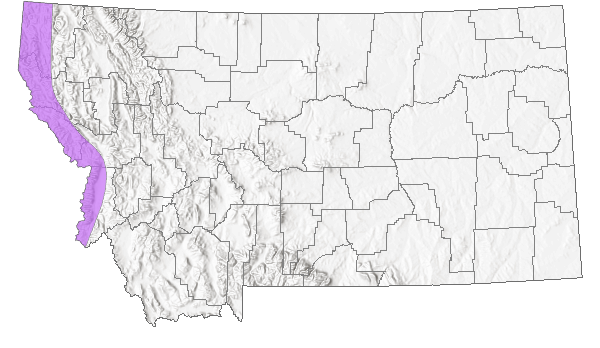
 Native
Native
Range Comments
Restricted to the northern Rocky Mountains of Idaho, and adjacent northeastern Washington, northeastern Oregon, and extreme western Montana (Burke 2013). Some Idaho records within a 2 km of Lookout Pass, Montana, but first recorded in Montana in 2015 from the Selway-Bitterroot Wilderness of the Bitterroot Mountains in Ravalli County. Elevation at the site is 1670 m (5480 ft). Likely occurs at other localities near the border with Idaho. Range and abundance in Montana poorly documented; current status needs investigation. Five live individuals were found at the Ravalli County site (Hendricks 2016).
Observations in Montana Natural Heritage Program Database
Number of Observations: 1
(Click on the following maps and charts to see full sized version)
Map Help and Descriptions
Relative Density
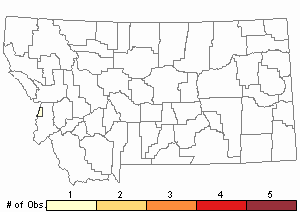
Recency
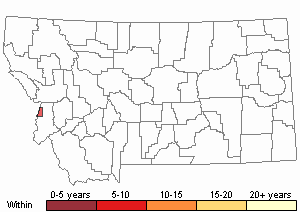

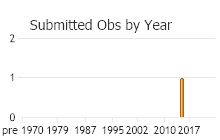
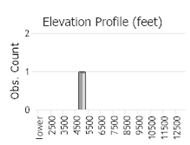 (Observations spanning multiple months or years are excluded from time charts)
(Observations spanning multiple months or years are excluded from time charts)
Habitat
Often found in Idaho at lower elevations in moist forest zones under mature closed-canopy ponderosa pine, Douglas-fir, grand fir, and Pacific yew. Sometimes in mossy talus under coarse organic debris, and sometimes associated with limestone and basalt (Frest and Johannes 1995, 1997, 2001). Habitat in Montana was under 70% closed canopy of Engelmann spruce, subalpine fir, and Douglas-fir with a ground cover of ferns and moss; on the underside of woody debris atop the ground and relatively near a small seepage (Hendricks 2016). Habitat in Montana is poorly documented.
Stewardship Responsibility
References
- Literature Cited AboveLegend:
 View Online Publication
View Online Publication Burke, T. E. 2013. Land snails and slugs of the Pacific Northwest. Corvallis, OR: Oregon State University Press. 344 p.
Burke, T. E. 2013. Land snails and slugs of the Pacific Northwest. Corvallis, OR: Oregon State University Press. 344 p. Frest, T.J. and E.J. Johannes. 1995. Interior Columbia Basin mollusk species of special concern. Final report to the Interior Columbia Basin Ecosystem Management Project, Walla Walla, WA. Contract #43-0E00-4-9112. 274 pp. plus appendices.
Frest, T.J. and E.J. Johannes. 1995. Interior Columbia Basin mollusk species of special concern. Final report to the Interior Columbia Basin Ecosystem Management Project, Walla Walla, WA. Contract #43-0E00-4-9112. 274 pp. plus appendices. Frest, T.J. and E.J. Johannes. 1997. Land snail survey of the lower Salmon River drainage, Idaho. Idaho Bureau of Land Management Technical Bulletin No. 97-18.
Frest, T.J. and E.J. Johannes. 1997. Land snail survey of the lower Salmon River drainage, Idaho. Idaho Bureau of Land Management Technical Bulletin No. 97-18. Frest, T.J. and E.J. Johannes. 2001. An annotated checklist of Idaho land and freshwater mollusks. Journal of the Idaho Academy of Science 36(2):1-51.
Frest, T.J. and E.J. Johannes. 2001. An annotated checklist of Idaho land and freshwater mollusks. Journal of the Idaho Academy of Science 36(2):1-51. Hendricks, P. 2016. First record of the land snail Pristiloma idahoense (Gastropoda: Pristilomidae) for Montana. Canadian Field-Naturalist. 130(3): 199-201.
Hendricks, P. 2016. First record of the land snail Pristiloma idahoense (Gastropoda: Pristilomidae) for Montana. Canadian Field-Naturalist. 130(3): 199-201.
- Web Search Engines for Articles on "Thinlip Tightcoil"
- Additional Sources of Information Related to "Snails / Slugs"





